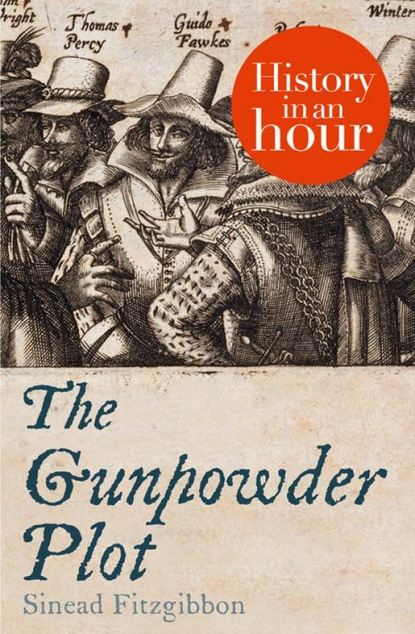По всем вопросам обращайтесь на: info@litportal.ru
(©) 2003-2025.
✖
The Gunpowder Plot: History in an Hour
Настройки чтения
Размер шрифта
Высота строк
Поля
The Gunpowder Plot: History in an Hour
Sinead Fitzgibbon
Love history? Know your stuff with History in an Hour.‘Remember, remember, the fifth of November’. The gunpowder plot is a famed tale of treachery that continues to fascinate and capture the imagination four hundred years on.The Gunpowder Plot in an Hour reveals the elaborate background to the infamous plot to blow up the Houses of Parliament and James I, the ultimate act of treason. This compelling and engaging account of one of the most famous historical events in English history follows the Catholic protagonists hatching their plan through to their inevitable, gruesome deaths.Learn who the Catholic traitors were, what drove them to such desperate measures, and how the plot was discovered. The Gunpowder Plot in an Hour gives a concise overview of this enduring event and is a must for all history lovers.Love history? Know your stuff with History in an Hour…
THE GUNPOWDER PLOT
History in an Hour
Sinead Fitzgibbon
About History in an Hour (#ulink_e4a6cc46-d4c5-59e7-afdd-e39f0687ed38)
History in an Hour is a series of ebooks to help the reader learn the basic facts of a given subject area. Everything you need to know is presented in a straightforward narrative and in chronological order. No embedded links to divert your attention, nor a daunting book of 600 pages with a 35-page introduction. Just straight in, to the point, sixty minutes, done. Then, having absorbed the basics, you may feel inspired to explore further.
Give yourself sixty minutes and see what you can learn …
To find out more visit http://historyinanhour.com or follow us on Twitter: http://twitter.com/historyinanhour
Contents
Title Page (#ua82f5bc4-e1a9-5dc9-8bca-0bff8d0c497a)
About History in an Hour (#ulink_72296a35-05ce-51f9-94f3-5fb2517ad046)
Introduction (#ulink_cd023cc7-f2db-54d1-965d-445bdcb718d6)
A Country Divided (#ulink_d5386091-1d1c-57fc-b6a1-84cf99a7d5c0)
The Conspirators (#ulink_333bc446-8b98-548a-bb60-f6dd262f6735)
The Hatching of a Plot (#ulink_e842e751-b58f-57c2-b1e0-aa06ff3266f8)
The Discovery (#litres_trial_promo)
An Attempt to Escape (#litres_trial_promo)
Torture and Capture (#litres_trial_promo)
Trial and Execution (#litres_trial_promo)
Repercussions, Traditions and Legacy (#litres_trial_promo)
Appendix 1: Key Players (#litres_trial_promo)
Appendix 2: The Gunpowder Plot Timeline (#litres_trial_promo)
Copyright (#litres_trial_promo)
Got Another Hour?
About the Publisher
Introduction (#ulink_ccf6e856-0520-5ca0-9992-55ffb26ae865)
Remember, remember, the fifth of November,
Gunpowder, Treason and Plot.
I see no reason why Gunpowder Treason
Should ever be forgot.
Like all good conspiracy stories, the tale of the Gunpowder Plot of 1605 is one that combines elements of mystery, intrigue, suspense and, of course, deception. It is the story of a small band of disaffected Catholics who, unhappy with the constraints placed on their religion by Elizabeth I and her successor, James I, decided to challenge the religious and political status quo. They would do this by committing the ultimate act of terrorism – the destruction of both king and Parliament. The plan was audacious and surprisingly simple – and came very close to succeeding. There have been innumerable terrorist conspiracies, both successful and otherwise, down through the ages, but the Gunpowder Plot has succeeded in capturing our imagination unlike any other. Over 400 years has passed since this daring scheme was discovered, and yet its legend continues undiminished. Every year, bonfires are lit the length and breadth of Britain to mark the Plot’s anniversary, a tradition which dates back to that fateful November night in 1605 when the Gunpowder Plot was uncovered at the eleventh hour.
This, in an hour, is the story of the Gunpowder Plot.
A Country Divided (#ulink_dd6401e9-9bc5-50bc-a078-5ab70c75a7be)
England at the turn of the seventeenth century was a country rife with political tensions and religious divisions, the roots of which can be traced back some seventy years to the reign of Henry VIII. The actions of this one man would have profound repercussions for his kingdom, condemning his people to decades of religious conflicts and persecution. The discord which resulted from Henry’s exploits would in turn give rise to one of the most audacious terrorist plots this country has ever seen – the Gunpowder Plot.
Henry VIII
During the early 1530s, Henry, in his desperation to marry Anne Boleyn, was frantically looking for a way to divorce his wife of almost twenty-five years, Catherine of Aragon. When numerous appeals to Rome for an annulment fell on deaf ears, Henry’s patience began to wear thin. Powerless in the face of the Pope’s authority, Henry grew increasingly resentful. Until this point, Henry had been a dutiful and pious Catholic. Despite this, relations between the English monarch’s court and Rome were invariably strained. Henry, accustomed to being in an authoritative position, often found it difficult to bend to the will of the Papacy. Ever the opportunist, the King’s attentions soon turned to the Protestant Reformation which at the time was sweeping the Continent.
Henry VIII
Recognising in this movement a chance to circumvent the authority of Rome, Henry began to endorse the Reformation’s ideals. Thus began a concerted campaign to wrest power from the Papacy. Denouncing the Catholic Church as corrupt and out of touch, Henry broke all ties with Rome in 1533. In doing so, he proclaimed himself, and not the Pope, to be the Supreme Head of the Church in England; the King was now bound only by his conscience in matters of religion and theology. Conveniently, his conscience proved to be no obstacle to his divorce from Catherine.
So began a marital merry-go-round which would last for more than a decade. Proving himself to be a fickle husband and obsessed with producing the necessary male heir, Henry would marry six times. These marriages would end by a variety of means: divorce, death or execution. They would, however, produce three children: Mary from his marriage to Catherine of Aragon; Elizabeth from his union with Anne Boleyn; and the longed-for son, Edward, from his third marriage to Jane Seymour. Henry’s offspring would each play a significant part in inflaming the religious tensions which were first ignited by their father.
Edward VI and Mary I
When Henry died in 1547, his youngest child and only male heir, Edward, ascended to the throne to become King Edward VI. He was only nine years old at the time of his coronation. Brought up in the new faith, Edward, together with his Protestant guardians, earnestly continued with Henry’s programme of reform. Under Edward’s reign, Henry’s policy of dissolution of the monasteries was completed. This left the Church all but bankrupt, with most of the wealth transferred to the King’s coffers. The reign of Edward VI, however, was not destined to last long. A sickly child, the young king died in 1553 at the age of fifteen. He left behind a country where the Church of England had become quite firmly established. This, however, was all about to change with the ascendancy of his half-sister Mary to the throne. During the turbulent years of her father’s religious reforms, Mary, Henry’s eldest child, had managed to retain her Catholicism in the face of severe opposition. In fact, it could be said that the harsh treatment of her mother, Catherine of Aragon, at Henry’s hands had only served to harden Mary against the very idea of Protestantism. Her unquestioning devotion to her mother’s religion was set in stone. It is hardly surprising, then, that when Mary became queen, she quickly set about accomplishing her long-held ambition of restoring England to the Catholic faith.
Unfortunately, in her zeal to undo all her father’s reforms, Mary revealed a hatred for Protestantism that was all-consuming. She regarded all adherents to the new religion as heretics, and displayed no compunction in burning at the stake those suspected of harbouring Protestants or with Protestant leanings themselves. In all, 237 men and 52 women met a painful end during Mary’s reign. This willingness to kill in the name of Catholicism gained her a reputation for mercilessness that would rival her father’s. History would not judge Mary’s actions in promoting the old faith kindly – she would be remembered for centuries to come as ‘Bloody Mary’.
Elizabeth I
After Mary’s death in 1558, the last of the Tudor children came to the throne. Like Edward before her, Elizabeth’s sympathies lay with the Protestant cause, and so her coronation saw the pendulum swing once again back to the Protestant religion.
Elizabeth I
A year later, in 1559, the Act of Supremacy and the Act of Uniformity were introduced, reinstating into law many edicts which had been repealed by Mary I. The Acts declared the celebration of Mass and other Catholic traditions illegal, while also enshrining Elizabeth’s supremacy over the Church of England. These new laws introduced fines for those who refused to attend Church of England services; abstainers were known as recusants. These measures were designed to make life very difficult for Catholics in England, and for the most part they succeeded in their aim. Catholic disillusionment set in, and the situation would soon worsen.
In 1570, in reaction to Elizabeth’s draconian measures against the Catholics in her realm, Pope Pius V issued the Papal Bull, Regnans in Excelsis. This missive ex-communicated Elizabeth from the Catholic Church, and as such absolved all Catholics of their allegiance to their Queen. In effect, the Papal Bull declared that Catholics had a duty to God before their monarch. This proclamation did little to improve conditions for the beleaguered Catholics of the Elizabethan era. All Catholics were now viewed as potential traitors to the Crown, effectively sanctioned by Rome.
The inexperienced Queen, fearful of uprisings against her authority, introduced more legislation. In a bid to prevent Catholics receiving religious instruction, priests were denounced as traitors and banned from English shores. Anybody found guilty of sheltering priests, or providing assistance to them in any way, would also be subject to the full force of the recusancy laws. Where once Catholicism was simply illegal, it was now regarded as high treason. Elizabeth did not hesitate to use this new legislation to her advantage; it soon became clear that she was as adept as her sister Mary at executing religious opponents and heretics.
These measures, however, failed in their ultimate aim of eradicating the Catholic threat; in fact, they succeeded only in forcing Catholics underground. While some priests did flee the country, many decided, in defiance of new laws, to remain in England. The fight to save the Catholic faith was aided by the arrival of hundreds of foreign-trained priests. The majority came from the English seminary in Douai, northern France – a college founded by the Jesuits in 1568 to instruct Englishmen in theology and provide training for priests. In all, over 450 priests arrived in England from foreign shores, of whom 130 were executed for their efforts to administer the Catholic faith. One such priest was Father Edmund Campion.
Sinead Fitzgibbon
Love history? Know your stuff with History in an Hour.‘Remember, remember, the fifth of November’. The gunpowder plot is a famed tale of treachery that continues to fascinate and capture the imagination four hundred years on.The Gunpowder Plot in an Hour reveals the elaborate background to the infamous plot to blow up the Houses of Parliament and James I, the ultimate act of treason. This compelling and engaging account of one of the most famous historical events in English history follows the Catholic protagonists hatching their plan through to their inevitable, gruesome deaths.Learn who the Catholic traitors were, what drove them to such desperate measures, and how the plot was discovered. The Gunpowder Plot in an Hour gives a concise overview of this enduring event and is a must for all history lovers.Love history? Know your stuff with History in an Hour…
THE GUNPOWDER PLOT
History in an Hour
Sinead Fitzgibbon
About History in an Hour (#ulink_e4a6cc46-d4c5-59e7-afdd-e39f0687ed38)
History in an Hour is a series of ebooks to help the reader learn the basic facts of a given subject area. Everything you need to know is presented in a straightforward narrative and in chronological order. No embedded links to divert your attention, nor a daunting book of 600 pages with a 35-page introduction. Just straight in, to the point, sixty minutes, done. Then, having absorbed the basics, you may feel inspired to explore further.
Give yourself sixty minutes and see what you can learn …
To find out more visit http://historyinanhour.com or follow us on Twitter: http://twitter.com/historyinanhour
Contents
Title Page (#ua82f5bc4-e1a9-5dc9-8bca-0bff8d0c497a)
About History in an Hour (#ulink_72296a35-05ce-51f9-94f3-5fb2517ad046)
Introduction (#ulink_cd023cc7-f2db-54d1-965d-445bdcb718d6)
A Country Divided (#ulink_d5386091-1d1c-57fc-b6a1-84cf99a7d5c0)
The Conspirators (#ulink_333bc446-8b98-548a-bb60-f6dd262f6735)
The Hatching of a Plot (#ulink_e842e751-b58f-57c2-b1e0-aa06ff3266f8)
The Discovery (#litres_trial_promo)
An Attempt to Escape (#litres_trial_promo)
Torture and Capture (#litres_trial_promo)
Trial and Execution (#litres_trial_promo)
Repercussions, Traditions and Legacy (#litres_trial_promo)
Appendix 1: Key Players (#litres_trial_promo)
Appendix 2: The Gunpowder Plot Timeline (#litres_trial_promo)
Copyright (#litres_trial_promo)
Got Another Hour?
About the Publisher
Introduction (#ulink_ccf6e856-0520-5ca0-9992-55ffb26ae865)
Remember, remember, the fifth of November,
Gunpowder, Treason and Plot.
I see no reason why Gunpowder Treason
Should ever be forgot.
Like all good conspiracy stories, the tale of the Gunpowder Plot of 1605 is one that combines elements of mystery, intrigue, suspense and, of course, deception. It is the story of a small band of disaffected Catholics who, unhappy with the constraints placed on their religion by Elizabeth I and her successor, James I, decided to challenge the religious and political status quo. They would do this by committing the ultimate act of terrorism – the destruction of both king and Parliament. The plan was audacious and surprisingly simple – and came very close to succeeding. There have been innumerable terrorist conspiracies, both successful and otherwise, down through the ages, but the Gunpowder Plot has succeeded in capturing our imagination unlike any other. Over 400 years has passed since this daring scheme was discovered, and yet its legend continues undiminished. Every year, bonfires are lit the length and breadth of Britain to mark the Plot’s anniversary, a tradition which dates back to that fateful November night in 1605 when the Gunpowder Plot was uncovered at the eleventh hour.
This, in an hour, is the story of the Gunpowder Plot.
A Country Divided (#ulink_dd6401e9-9bc5-50bc-a078-5ab70c75a7be)
England at the turn of the seventeenth century was a country rife with political tensions and religious divisions, the roots of which can be traced back some seventy years to the reign of Henry VIII. The actions of this one man would have profound repercussions for his kingdom, condemning his people to decades of religious conflicts and persecution. The discord which resulted from Henry’s exploits would in turn give rise to one of the most audacious terrorist plots this country has ever seen – the Gunpowder Plot.
Henry VIII
During the early 1530s, Henry, in his desperation to marry Anne Boleyn, was frantically looking for a way to divorce his wife of almost twenty-five years, Catherine of Aragon. When numerous appeals to Rome for an annulment fell on deaf ears, Henry’s patience began to wear thin. Powerless in the face of the Pope’s authority, Henry grew increasingly resentful. Until this point, Henry had been a dutiful and pious Catholic. Despite this, relations between the English monarch’s court and Rome were invariably strained. Henry, accustomed to being in an authoritative position, often found it difficult to bend to the will of the Papacy. Ever the opportunist, the King’s attentions soon turned to the Protestant Reformation which at the time was sweeping the Continent.
Henry VIII
Recognising in this movement a chance to circumvent the authority of Rome, Henry began to endorse the Reformation’s ideals. Thus began a concerted campaign to wrest power from the Papacy. Denouncing the Catholic Church as corrupt and out of touch, Henry broke all ties with Rome in 1533. In doing so, he proclaimed himself, and not the Pope, to be the Supreme Head of the Church in England; the King was now bound only by his conscience in matters of religion and theology. Conveniently, his conscience proved to be no obstacle to his divorce from Catherine.
So began a marital merry-go-round which would last for more than a decade. Proving himself to be a fickle husband and obsessed with producing the necessary male heir, Henry would marry six times. These marriages would end by a variety of means: divorce, death or execution. They would, however, produce three children: Mary from his marriage to Catherine of Aragon; Elizabeth from his union with Anne Boleyn; and the longed-for son, Edward, from his third marriage to Jane Seymour. Henry’s offspring would each play a significant part in inflaming the religious tensions which were first ignited by their father.
Edward VI and Mary I
When Henry died in 1547, his youngest child and only male heir, Edward, ascended to the throne to become King Edward VI. He was only nine years old at the time of his coronation. Brought up in the new faith, Edward, together with his Protestant guardians, earnestly continued with Henry’s programme of reform. Under Edward’s reign, Henry’s policy of dissolution of the monasteries was completed. This left the Church all but bankrupt, with most of the wealth transferred to the King’s coffers. The reign of Edward VI, however, was not destined to last long. A sickly child, the young king died in 1553 at the age of fifteen. He left behind a country where the Church of England had become quite firmly established. This, however, was all about to change with the ascendancy of his half-sister Mary to the throne. During the turbulent years of her father’s religious reforms, Mary, Henry’s eldest child, had managed to retain her Catholicism in the face of severe opposition. In fact, it could be said that the harsh treatment of her mother, Catherine of Aragon, at Henry’s hands had only served to harden Mary against the very idea of Protestantism. Her unquestioning devotion to her mother’s religion was set in stone. It is hardly surprising, then, that when Mary became queen, she quickly set about accomplishing her long-held ambition of restoring England to the Catholic faith.
Unfortunately, in her zeal to undo all her father’s reforms, Mary revealed a hatred for Protestantism that was all-consuming. She regarded all adherents to the new religion as heretics, and displayed no compunction in burning at the stake those suspected of harbouring Protestants or with Protestant leanings themselves. In all, 237 men and 52 women met a painful end during Mary’s reign. This willingness to kill in the name of Catholicism gained her a reputation for mercilessness that would rival her father’s. History would not judge Mary’s actions in promoting the old faith kindly – she would be remembered for centuries to come as ‘Bloody Mary’.
Elizabeth I
After Mary’s death in 1558, the last of the Tudor children came to the throne. Like Edward before her, Elizabeth’s sympathies lay with the Protestant cause, and so her coronation saw the pendulum swing once again back to the Protestant religion.
Elizabeth I
A year later, in 1559, the Act of Supremacy and the Act of Uniformity were introduced, reinstating into law many edicts which had been repealed by Mary I. The Acts declared the celebration of Mass and other Catholic traditions illegal, while also enshrining Elizabeth’s supremacy over the Church of England. These new laws introduced fines for those who refused to attend Church of England services; abstainers were known as recusants. These measures were designed to make life very difficult for Catholics in England, and for the most part they succeeded in their aim. Catholic disillusionment set in, and the situation would soon worsen.
In 1570, in reaction to Elizabeth’s draconian measures against the Catholics in her realm, Pope Pius V issued the Papal Bull, Regnans in Excelsis. This missive ex-communicated Elizabeth from the Catholic Church, and as such absolved all Catholics of their allegiance to their Queen. In effect, the Papal Bull declared that Catholics had a duty to God before their monarch. This proclamation did little to improve conditions for the beleaguered Catholics of the Elizabethan era. All Catholics were now viewed as potential traitors to the Crown, effectively sanctioned by Rome.
The inexperienced Queen, fearful of uprisings against her authority, introduced more legislation. In a bid to prevent Catholics receiving religious instruction, priests were denounced as traitors and banned from English shores. Anybody found guilty of sheltering priests, or providing assistance to them in any way, would also be subject to the full force of the recusancy laws. Where once Catholicism was simply illegal, it was now regarded as high treason. Elizabeth did not hesitate to use this new legislation to her advantage; it soon became clear that she was as adept as her sister Mary at executing religious opponents and heretics.
These measures, however, failed in their ultimate aim of eradicating the Catholic threat; in fact, they succeeded only in forcing Catholics underground. While some priests did flee the country, many decided, in defiance of new laws, to remain in England. The fight to save the Catholic faith was aided by the arrival of hundreds of foreign-trained priests. The majority came from the English seminary in Douai, northern France – a college founded by the Jesuits in 1568 to instruct Englishmen in theology and provide training for priests. In all, over 450 priests arrived in England from foreign shores, of whom 130 were executed for their efforts to administer the Catholic faith. One such priest was Father Edmund Campion.









